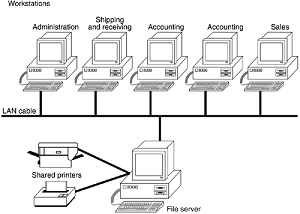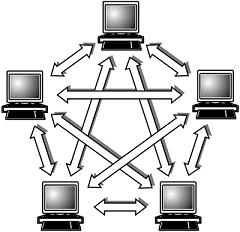Client/Server and Peer Networks
Although every computer on a LAN is connected to every other computer, they do not necessarily all communicate with each other. There are two basic types of LANs, based on the communication patterns between the machines—client/server networks and peer-to-peer networks.
Client/Server Networks
On a client/server network, every computer has a distinct role, that of either a client or a server. A server is designed to share its resources among the client computers on the network.
Typically, servers are located in secured areas, such as locked closets or data centers, because they hold an organization's most valuable data and do not have to be accessed by operators on a continuous basis. The rest of the computers on the network function as clients
Servers
A dedicated server computer typically has a faster processor, more memory, and more storage space than a client because it might have to service dozens or even hundreds of users at the same time.
High-performance servers also might use two or more processors, use the 64-bit version of the PCI expansion slot for server-optimized network interface cards, and have redundant power supplies.
The server runs a special network operating system—such as Windows NT Server, Windows 2000 Server, Windows Server 2003, Linux, Unix, or Novell NetWare—that is designed solely to facilitate the sharing of its resources. These resources can reside on a single server or on a group of servers.
When more than one server is used, each server can "specialize" in a particular task (file server, print server, fax server, email server, and so on) or provide redundancy (duplicate servers) in case of server failure. For very demanding computing tasks, several servers can act as a single unit through the use of parallel processing.
Clients
A client computer communicates only with servers, not with other clients. A client system is a standard PC that is running an operating system such as Windows 9x, Windows Me, Windows 2000 Professional, or Windows XP.
These versions of Windows contain the client software that enables the client computers to access the resources that servers share. Older operating systems, such as Windows 3.x and DOS, require add-on network client software.
Peer-to-Peer Network
By contrast, on a peer-to-peer network, every computer is equal and can communicate with any other computer on the network to which it has been granted access rights.
Essentially, every computer on a peer-to-peer network can function as both a server and a client; any computer on a peer-to-peer network is considered a server if it shares a printer, a folder, a drive, or some other resource with the rest of the network.
This is why you might hear about client and server activities, even when the discussion is about a peer-to-peer network. Peer-to-peer networks can be as small as two computers or as large as hundreds of systems.
Although there is no theoretical limit to the size of a peer-to-peer network, performance drops significantly and security becomes a major headache on peer-based networks with more than 10 computers.
Also, Microsoft imposes a 10-station limit on computers running Windows 2000 Professional or XP Professional that are sharing resources with other systems.
For these reasons, I recommend that you switch to a client/server network when your network climbs above about 10 stations.
Peer-to-peer networks are more common in small offices or within a single department of a larger organization. The advantage of a peer-to-peer network is that you don't have to dedicate a computer to function as a file server. Instead, every computer can share its resources with any other.
The potential disadvantages to a peer-to-peer network are that typically less security and less control exist because users normally administer their own systems, whereas client/server networks have the advantage of centralized administration.
Client/Server vs Peer-to-Peer Networks
Client/server LANs offer enhanced security for shared resources, greater performance, increased backup efficiency for network-based data, and the potential for the use of redundant power supplies and RAID drive arrays. Client/server LANs also have a much greater cost to purchase and maintain.
Table below compares client/server and peer-to-peer server networking.
| Item | Client/Server | Peer-to-Peer |
|---|---|---|
| Access control | Via user/group lists of permissions; single password provides a user access to only the resources on his list; users can be given several different levels of access. | Via password lists by resource; each resource requires a separate password; all-or-nothing access; no centralized user list. |
| Security | High because access is controlled by user or by group identity. | Low because knowing the password gives anybody access to a shared resource. |
| Performance | High because the server doesn't waste time or resources handling workstation tasks. | Low because servers often act as workstations. |
| Hardware Cost | High, due to specialized design of server, high-performance nature of hardware, and redundancy features. | Low because any workstation can become a server by sharing resources. |
| Software Cost | License fees per workstation user are part of the cost of the Network Operating System server software (Windows NT and Windows 2000 Server, .NET Server, and Novell NetWare). | It's free; all client software is included with any release of Windows 9x, Windows NT Workstation, Windows 2000 Professional, Windows Me, and WindowsXP. |
| Backup | Centralized when data is stored on server; enables use of high-speed, high-capacity tape backups with advanced cataloging. | Left to user decision; usually mixture of backup devices and practices at each workstation. |
| Redundancy | Duplicate power supplies, hot-swappable drive arrays, and even redundant servers are common; network OS normally is capable of using redundant devices automatically. | No true redundancy among either peer "servers" or clients; failures require manual intervention to correct, with a high possibility of data loss. |
Windows 9x, Windows Me, Windows NT, Windows 2000, and Windows XP have peer-to-peer networking capabilities built into them. Because Windows, from version 95 forward, uses Plug and Play technology, installing network interface cards in a collection of these systems is relatively easy. Simply connect them with the correct kind of cable, and build your own peer-to-peer network.

